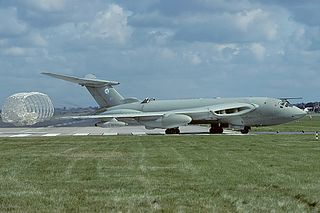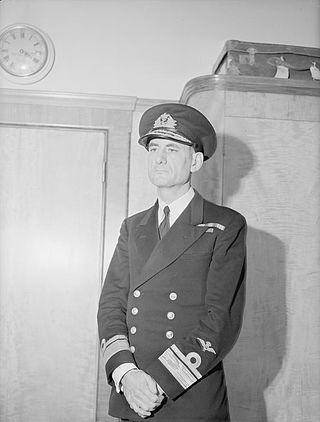Related Research Articles

The Air Ministry was a department of the Government of the United Kingdom with the responsibility of managing the affairs of the Royal Air Force, that existed from 1918 to 1964. It was under the political authority of the Secretary of State for Air.

The British Aircraft Corporation (BAC) was a British aircraft manufacturer formed from the government-pressured merger of English Electric Aviation Ltd., Vickers-Armstrongs (Aircraft), the Bristol Aeroplane Company and Hunting Aircraft in 1960. Bristol, English Electric and Vickers became "parents" of BAC with shareholdings of 20%, 40% and 40% respectively. BAC in turn acquired the share capital of their aviation interests and 70% of Hunting Aircraft several months later.

Edwin Duncan Sandys, Baron Duncan-Sandys, was a British politician and minister in successive Conservative governments in the 1950s and 1960s. He was a son-in-law of Winston Churchill and played a key role in promoting European unity after World War II.

John Thomson Stonehouse was a British Labour and Co-operative Party politician, businessman and minister who attended the cabinet of Harold Wilson. Stonehouse is remembered for his unsuccessful attempt at faking his own death in 1974. It is also alleged that Stonehouse had been an agent for the Czechoslovak Socialist Republic military intelligence.

The Handley Page Victor is a British jet-powered strategic bomber developed and produced by Handley Page during the Cold War. It was the third and final V bomber to be operated by the Royal Air Force (RAF), the other two being the Vickers Valiant and the Avro Vulcan. Entering service in 1958, the Victor was initially developed as part of the United Kingdom's airborne nuclear deterrent, but it was retired from the nuclear mission in 1968, following the discovery of fatigue cracks which had been exacerbated by the RAF's adoption of a low-altitude flight profile to avoid interception, and due to the pending introduction of the Royal Navy's submarine-launched Polaris missiles in 1969.

The Gloster Javelin is a twin-engined all-weather interceptor aircraft that served with Britain's Royal Air Force from the mid-1950s until the late 1960s. It was a T-tailed delta-wing aircraft designed for night and all-weather operations and was the last aircraft design to bear the Gloster name. Introduced in 1956 after a lengthy development period, the aircraft received several upgrades during production to its engines, radar and weapons, including support for the De Havilland Firestreak air-to-air missile.

The Hawker P.1127 and the Hawker Siddeley Kestrel FGA.1 are the British experimental and development aircraft that led to the Hawker Siddeley Harrier, the first vertical and/or short take-off and landing (V/STOL) jet fighter-bomber.

The Conservative government of the United Kingdom that began in 1957 and ended in 1964 consisted of three ministries: the first Macmillan ministry, second Macmillan ministry, and then the Douglas-Home ministry. They were respectively led by Harold Macmillan and Sir Alec Douglas-Home, who were appointed by Queen Elizabeth II.
The Ministry of Technology was a department of the government of the United Kingdom, sometimes abbreviated as "MinTech". The Ministry of Technology was established by the incoming government of Harold Wilson in October 1964 as part of Wilson's ambition to modernise the state for what he perceived to be the needs of the 1960s. The pledge was included in the Labour Party's 1964 general election manifesto: "A Labour Government will .. [set] up a Ministry of Technology to guide and stimulate a major national effort to bring advanced technology and new processes into the industry."

Garrett AiResearch was a manufacturer of turboprop engines and turbochargers, and a pioneer in numerous aerospace technologies. It was previously known as Aircraft Tool and Supply Company, Garrett Supply Company, AiResearch Manufacturing Company, or simply AiResearch. In 1964, Garrett AiResearch merged with Signal Oil & Gas, to form a company renamed in 1968 to Signal Companies. In 1985, it merged with Allied Corporation, forming AlliedSignal. In 1999 AlliedSignal acquired Honeywell and adopted the Honeywell name.
Aviation in the United Kingdom refers to the activities surrounding mechanical flight in the United Kingdom, in both civilian and military contexts.

The 4756th Air Defense Wing was the designation of two different discontinued United States Air Force organizations. Both wings were stationed at Tyndall Air Force Base, Florida and fulfilled similar missions. The first was organized in 1957 when Air Defense Command (ADC) assumed responsibility for managing Tyndall from Air Training Command and focused on weapons testing and development and evaluating the readiness of ADC fighter units. The wing also controlled a ground control intercept radar squadron. This wing was discontinued in 1960 and its mission transferred to its parent 73d Air Division.
Charles Harvard Gibbs-Smith was a British polymath historian of aeronautics and aviation. His obituary in The Times described him as "the recognised authority on the early development of flying in Europe and America" Richard P. Hallion called him "The greatest of all historians of early aviation".

The Anti-Concorde Project, founded by environmental activist Richard Wiggs, challenged the idea of supersonic passenger transport, and curtailed Concorde's commercial prospects. When Concorde entered service in 1976, of the 74 options held at the time of the first flight, only those for the state airlines of Britain (BOAC) and France were taken up, so that only 20 were built, although flights were also flown for Braniff International and Singapore Airlines. It triggered research into the factors affecting the creation of sonic booms, which led to the Shaped Sonic Boom Demonstration which achieved their goal of reducing the intensity of sonic booms, and echoed public concern about aircraft noise that resulted in more restrictive noise limits for aircraft and airport operations, as well as changes in both operating procedures and aircraft design to further reduce noise levels.

Rear-Admiral Sir Matthew Sausse Slattery, was a British naval officer, military aviator and businessman. He was the managing director and chairman of Short Brothers and Harland, chairman of British Overseas Airways Corporation and latterly served as chairman of Hawthorn Leslie and Company. He was also a board member of Bristol Aeroplane Company and The National Bank.

The Air Division originally known as the Air Section and later known as the Naval Air Division was first established in 1924 and it was a Directorate of the Admiralty Naval Staff, that was initially responsible for operational control of aircraft supplied to the Royal Navy by the Air Ministry. In 1939 it was gained full control for the all matters relating to administration, control, policy and organisation of the Fleet Air Arm, it underwent various name changes until it was absorbed as part of the merger of the Admiralty into the new Ministry of Defence in April 1964 as part of the Navy Department where it continued until May 1966 when its remit was changed and when became the Directorate of Naval Warfare.
Sir Ronald Henry Melville, KCB was an English civil servant. Educated at Magdalene College, Cambridge, he entered the civil service in 1934 as an official in the Air Ministry. For much of the Second World War, he was private secretary to the Secretary of State for Air. In 1960, he moved to the War Office and in 1964 he was appointed Second Permanent Secretary of the Ministry of Defence. He then served as Permanent Secretary of the Ministry of Aviation from 1966 to 1967, when it was merged into the Ministry of Technology; Melville was then Secretary with responsibility for aviation matters. In 1970, he was appointed Permanent Secretary of the Ministry of Aviation Supply, serving until it was abolished in 1971.
References
- ↑ Edgerton, David (1996). Science, technology, and the British industrial "decline", 1870-1970. Cambridge; New York, NY, USA: Cambridge University Press, p. 40. ISBN 978-0-521-57127-2.
- 1 2 3 4 5 6 7 David Butler and Gareth Butler, Twentieth Century British Political Facts 1900-2000, Macmillan 2000, p. 27.
- 1 2 3 4 5 6 Butler and Butler, p. 58.
- 1 2 3 4 5 Butler and Butler, p. 30.
- 1 2 3 4 5 Butler and Butler, p. 301.
- ↑ Flight International , no. 2756, vol. 81, 4 January 1962, p. 2.